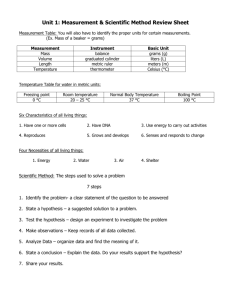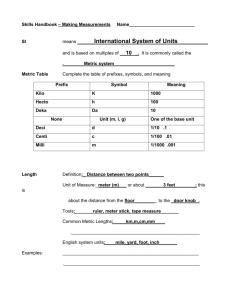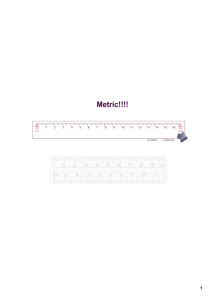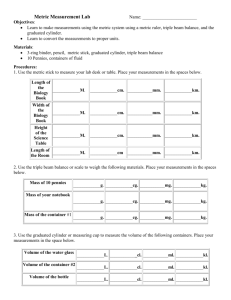Scientific Method
advertisement
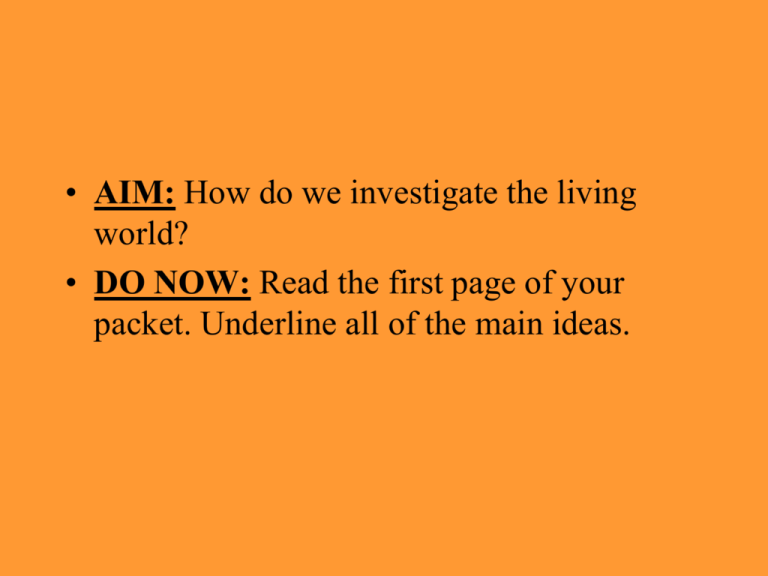
• AIM: How do we investigate the living world? • DO NOW: Read the first page of your packet. Underline all of the main ideas. Thursday 9/10/15 • AIM: How can we set up controlled experiments? • DO NOW: Over the summer I observed that my sunflowers that were in my yard were smaller than the sunflowers in the alley. How can I determine why this happened? • HOMEWORK: Text read 11-13 Scientific Method 1. Make an observation Based on your 5 senses 2. Research find out what is already known about your subject, & make your own observations 3. Form a Hypothesis an educated guess or possible answer to your observation that is based on your research 4. Experiment set up a situation to test your hypothesis 5. Record, Organize and analyzeData • • keep track of your measurements and observations use graphs and data tables to identify trends in the data 6. Conclusion • • • • does data support hypothesis?? explain what the data means State if your hypothesis is true or false Conclusions must be based on hard evidence from your data Tuesday 9/21/10 • AIM: How can we identify independent and dependant variables in an experiment? • DO NOW: Scientific Method handout, Back Page, Francisco Redi • Homework: Textbook Read pages 10-12. Answer questions 1,2 and 5 on page 13 Designing an experiment • Must have a purpose for investigation • Experiment must be based on research, a previous experiment or an observation • Your EXPERIMENT should be based on your hypothesis Controlled Experiment • Always setup in 2 sets – Control Group – Experimental Group • an experiment in which only one variable is manipulated at a time in order to establish a cause/effect relationship. • Why is it important to only manipulate one variable at a time? • You don't want more than one variable, or thing that you're testing, because then, you don't know which variable produced the result you obtained. Which experimental setup is correct and WHY? Hypothesis, Theory & Law Hypothesis: Prediction • • needs to be tested, may or may not be correct Theory: Explanation • • a former hypothesis that has been supported by many experiments can still be changed or discarded Law • a theory that scientists are extremely confident in (ex: the law of gravity) Tuesday 9/22/09 • AIM: How can we set up a controlled experiment? • DO NOW: 1- Copy your hw. 2- Use your plant research projects to explain what seed germination is. • Homework: In your project section, on a clean sheet of paper, write your heading and develop a hypothesis and controlled experiment related to your plant research. Identify your independent and dependant variables, control and experimental groups • YOU WILL BE TESTING THIS HYPOTHESIS IN CLASS! Heading • Hypothesis: • Experiment – Independent Variable – Dependant Variable – Control Group Experimental Group Seed germination Controlled Experiments • Set up two or more groups for comparison • Groups are set up to be alike in all ways except one • The one difference between the two groups at the start of the experiment is called the “independent variable” • The INdependent variable is the one you are IN control of! Cause of change • Dependant variable: Effected by the independent variable • Experimental Group(s) is (are) exposed to the independent variable, the Control Group is not Designing a controlled experiment • Control setup use all the same equipment, same conditions, but no variables are tested. – Provides a baseline for which to compare the results with the experimental setup. • Experimental setup is set up exactly the same way as the CONTROL, but one thing that you want to measure is factored in. – Uses the independent variable (cause) which determines the dependent variable (effect). Procedure • Experimental procedures must be very detailed and precise • Must include specifics about amounts, materials, temperatures and data collection • Must be written step by step Characteristics of Good Experiments Use large numbers in each group, this increases the reliability of your results Validity-other scientists should be able to get similar results if they repeat your procedures Cautious Conclusions • * don’t overstate the meaning of your data • results could be affected by factors that you are unaware of Wednesday 9/22/10 • AIM: How can we organize our data? • DO NOW: Explain how your height has changed since the first grade. • Homework: Textbook Read page 13. Answer questions 3 and 4 page 13 How has your shoe size changed since the first grade? Give an estimate for each year. Mrs Naus’shoe height over the years How can we organize this data in a more organized manor? What are the different types of graphs we can make? Bar graphs, line graphs, pie charts Using the data you collected, organize your shoe size into a table How can we use our table to build a graph? Setting up a line graph • Step 1:Identify Variables: – – • Independent: Goes on the X-axis Dependent: Goes on the Y-axis Step 2: Determine the variable range – • Subtract the lowest data variable from the highest data variable Step 3:Determine a scale(the numerical value for each square) that best fits the range of each variable. – Spread the graph to use MOST of the available space. Setting up a line graph • Step 4: Number and label each axis. – This tells what data the lines on your graph represent. • Step 5: Plot the data points. – Create a key or legend for multiple parts of data • Step 6: Draw the graph • Step 7: Title the graph – your title should clearly tell what the graph is about Thursday 9/23/10 • Homework: Text read pages 15 and 16 answer the reading check questions found within the reading DO NOW: Thursday 10/1/09 • Use the data table to create a line graph TIME (sec) Heart Rate (bpm) 5 18 10 22 15 27 20 35 25 45 30 52 35 45 40 37 45 26 50 15 • Using the following Time data table create a graph(days) Growth Growth Control(cm) Exp. (cm) 1 0 2 2 1 3 3 3 4 4 6 5 Monday 10/5/09 • AIM: Why is it important to be safe in the lab? • DO NOW: Read the paragraph and underline the procedures you think are incorrect • HOMEWORK: Lab Safety Study Sheet • EXAM FRIDAY! • Tuesday 10/6/09 • AIM: What are some of the lab instruments that help us perform scientific experiments? • DO NOW: handout Lab study sheet • Homework: Lab Instrument handout EXAM Friday • Scientific Method • Controlled Experiments: ind vs dep variable – Control vs experimental grps – Setting up line graphs • Lab safety • Lab instruments Lab Equipment Goggles USED TO PROTECT YOUR EYES DURING EXPERIMEN TS Gloves USED TO PROTECT YOUR HANDS DURING EXPERIMENTS Meter stick Used to measure distance has millimeters, centimeters & inches on reverse Thermometer MEASURE TEMPERATURE IN DEGREES CELSIUS (OC) Triple Beam Balance MEASURE THE MASS IN GRAMS (g) Beaker Beakers hold solids or liquids Transfer of substances Measure volume Erlenmeyer flask • Erlenmeyer flasks hold solids or liquids • Measure volume Graduated Cylinder A graduated cylinder is used to measure volumes of liquids. Milli Liter or Liter Test tubes • used to hold small amounts of liquid Thursday Rubber Stoppers Rubber stoppers are used to close containers to avoid spillage or contamination. Containers should never be heated when there is a stopper in place. Test tube holder • is useful for holding a test tube which is too hot to handle. Thursday • AIM: How do lab instruments help us perform controlled experiments? • DO NOW: Get your plants. Today will be your last measurement. • Homework: your Final research project is due on Tuesday Test Tube Racks Test tube racks are for holding and organizing test tubes on the laboratory counter. Plastic racks may melt in contact with very hot test tubes. Glass Stir Rod A glass rod is used to manually stir solutions. It can also be used to transfer a single drop of a solution. Glass Tubing • USED TO TRANSFER GASSES FROM DIFFERENT CONTAINERS Funnel A funnel is used to aid in the transfer of liquid from one vessel to another. Bunsen Burner Bunsen burners are used for the heating of nonvolatile liquids and solids. Ringstands and their Components Ringstands are a safe and convenient way to perform reactions that require heating using a Bunsen burner. Ringstands and their Components Iron Rings Iron rings connect to a ringstand and provide a stable, elevated platform for the reaction. Ringstands and their Components Utility Clamps Utility clamps are used to secure test tubes, distillation columns, and burets to the ringstand. Litmus Paper Red litmus paper is used to identify bases. Blue litmus paper is used to identify acids. • AIM: How do we take measurements in Life Science? • Do Now: Take Plant measurements • Homework: Data table and graph handout What is the Metric System? • The metric system is a system of measurement that is based on the number ten • It is often used in science and in countries around the world How is it different? • The metric system uses meters, grams, liters and Celsius • The English System uses feet, ounces, gallons and Fahrenheit What can be measured? • The metric system can be used to measure mass, volume, length, and temperature Anyone want to work for me this weekend What are units? •Words used to describe numbers •Example: meters, liters, grams, %, $… What are… Units Tools 1. Length Meter (m) Metric ruler 2. Volume Metric ruler or Liter, mL graduated cylinder Triple-beam Grams (g) balance g/ml or g/cm3 Tools for mass & volume 3. Mass 4. Density 5. Temperature cm3 = ºC or K thermometer What is matter? • Anything that has mass & takes up space • Examples: Solid, Liquids, & Gases What is mass? • Mass is the amount of matter in an object • Triple beam balance is used to measure mass • Measured in grams What is weight? • Weight is the amount of gravity that acts upon an object Are mass and weight the same? • Mass and weight are different. • Mass is the amount of matter in an object and weight is determined by the amount of gravity and matter in an object. • This is why your weight changes on different planets What is volume? • Volume is the amount of space an object occupies What is length? • Length is the distance between two points What is temperature? • Temperature is the average motion of particles • We can relate this motion to how hot or cold it is. What is density? • Density is how much mass an object has in a given space. • The formula for density is: Density = _ Mass__ Volume How do we measure length? • Length is measured using a metric ruler or meter stick • The metric units for length are the meter (m), centimeter (cm), and the millimeter (mm) How do we measure volume? • We use a graduated cylinder for liquids • We use a ruler for rectangular solids (L x W x H) • We use the water displacement method to determine the volume of irregularly shaped objects • The metric units for volume are the liter (L), the cubic centimeter (cm³), and the milliliter (mL) Volume of a liquid • Measured with a Graduated Cylinder, Beaker or Erlenmeyer flask • Measured in Liters The amount of space an object takes up Graduated Cylinder mL Volume of a solid • Calculated – Length x width x height • Measured in units3 Metric ruler Length x Width x Height (L x W x H) Volume Displacement 1. Add at least 20 mL of water to graduated cylinder. 2. Place the object in the water. 3. Note where the water level rises & then subtract: Final Water Level - Initial Water Level = Volume of the Object 50 mL 55 mL 5 mL How do we measure mass? • Mass is measured by using a balance • The metric units for mass are the gram (g), and kilogram (kg) The amount of matter in a given object Triple-beam balance Grams (g) mg 499 g 578.6 g 389.3 g How do we measure temperature? • Temperature is measured using a thermometer • The metric unit for temperature is Celsius (°C) Length Liter Gram ºC Metric Ruler Volume Triple-beam balance Temperature Mass = The amount of matter in an object Weight = The gravitational pull on the mass of an object

